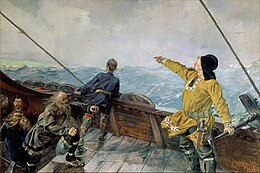
Back Vinland Afrikaans Winland ANG فينلاند Arabic Вінланд Byelorussian Винланд Bulgarian ভিনল্যান্ড Bengali/Bangla Vinland Catalan Vinland Czech Vinland Danish Vinland German
| Part of a series on the |
| Norse colonization of North America |
|---|
 |

Vinland, Vineland,[2][3] or Winland[4] (Old Norse: Vínland hit góða, lit. 'Vinland the Good') was an area of coastal North America explored by Vikings. Leif Eriksson landed there around 1000 AD, nearly five centuries before the voyages of Christopher Columbus and John Cabot.[5] The name appears in the Vinland Sagas, and describes Newfoundland and the Gulf of Saint Lawrence as far as northeastern New Brunswick. Much of the geographical content of the sagas corresponds to present-day knowledge of transatlantic travel and North America.[6]
In 1960, archaeological evidence of the only known Norse site in North America,[7][8] L'Anse aux Meadows, was found on the northern tip of the island of Newfoundland. Before the discovery of archaeological evidence, Vinland was known only from the sagas and medieval historiography. The 1960 discovery further proved the pre-Columbian Norse exploration of mainland North America.[7] L'Anse aux Meadows has been hypothesized to be the camp Straumfjörð mentioned in the Saga of Erik the Red.[9][10]
- ^ "L'Anse aux Meadows National Historic Site". UNESCO. Retrieved 21 June 2020.
- ^ Laurence Marcellus Larson in Canute the Great: 995 (circ.)-1035 and the Rise of Danish Imperialism During the Viking Age, New York: Putnam, 1912 p. 17
- ^ Elizabeth Janeway in The Vikings, New York, Random House, 1951 throughout
- ^ Danver, Steven L. (2010). Popular Controversies in World History: Investigating History's Intriguing Questions. Vol. 4. ABC-CLIO. p. 2. ISBN 978-1-59884-078-0.
- ^ William C. Wonders (2003). Canada's Changing North. McGill-Queen's Press - MQUP. pp. 28–29. ISBN 978-0-7735-7132-7.
- ^ Sigurdsson, Gisli (2008). The Vinland Sagas. London: Penguin. p. xv. ISBN 978-0-140-44776-7. Retrieved 21 June 2020.
The sagas are still our best proof that such voyages to the North American continent took place. Coincidence or wishful thinking simply cannot have produced descriptions of topography, natural resources and native lifestyles unknown to people in Europe that can be corroborated in North America.
- ^ a b "L'Anse aux Meadows". L'Anse aux Meadows National Historic Site of Canada. Parks Canada. 2018. Retrieved 21 December 2018.
Here [L'Anse aux Meadows] Norse expeditions sailed from Greenland, building a small encampment of timber-and-sod buildings …
- ^ Ingstad, Helge; Ingstad, Anne Stine (2001). The Viking Discovery of America: The Excavation of a Norse Settlement in L'Anse aux Meadows, Newfoundland. Checkmark Books. ISBN 0-8160-4716-2.
- ^ "Is L'Anse aux Meadows Vinland?". L'Anse aux Meadows National Historic Site of Canada. Parks Canada. 2003. Archived from the original on 22 May 2007. Retrieved 20 April 2010.
- ^ Significance of the discovery of butternut shells at L'Anse aux Meadows: Birgitta Wallace, "The Norse in Newfoundland: L'Anse aux Meadows and Vinland", The New Early Modern Newfoundland: Part 2 (2003), Vol. 19, No. 1. "Many scholars have dismissed L’Anse aux Meadows as peripheral in the Vinland story (Kristjánsson 2005:39). I myself held that view for a long time. I am now contending that L’Anse aux Meadows is in fact the key to unlocking the Vinland sagas. Two factors crystallized this idea in my mind. One was my subsequent research into early French exploitation outposts in Acadia (Wallace 1999) and the nature of migration (Anthony 1990) [...] The second signal was the identification of butternut remains in the Norse stratum at L’Anse aux Meadows. Here was the smoking gun that linked the limited environment of northern Newfoundland with a lush environment in the Gulf of St. Lawrence, where wild grapes did indeed exist. The mythical Vinland had a basis in archaeological fact." Birgitta Wallace, "L’Anse aux Meadows, Leif Eriksson’s Home in Vinland", Norse Greenland: Selected Papers from the Hvalsey Conference 2008 Journal of the North Atlantic, 2009, 114-125.